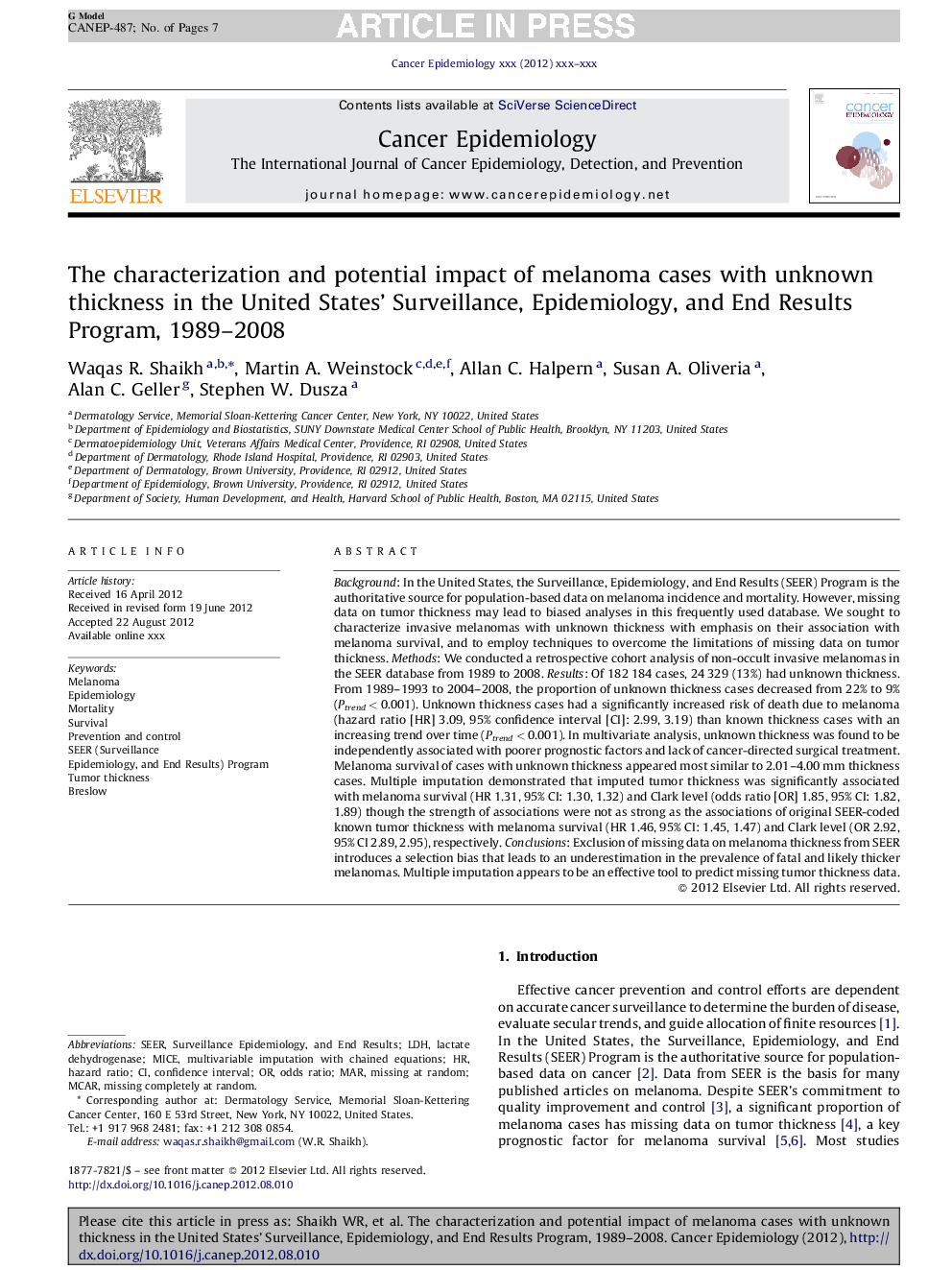| کد مقاله | کد نشریه | سال انتشار | مقاله انگلیسی | نسخه تمام متن |
|---|---|---|---|---|
| 10897482 | 1083852 | 2013 | 7 صفحه PDF | دانلود رایگان |
عنوان انگلیسی مقاله ISI
The characterization and potential impact of melanoma cases with unknown thickness in the United States' Surveillance, Epidemiology, and End Results Program, 1989-2008
ترجمه فارسی عنوان
مشخصه و تاثیر بالقوه موارد ملانوما با ضخامت ناشناخته در برنامه های نظارت، اپیدمیولوژی و برنامه های پایه ایالات متحده، 1989-2008
دانلود مقاله + سفارش ترجمه
دانلود مقاله ISI انگلیسی
رایگان برای ایرانیان
کلمات کلیدی
MARMCARBreslowEpidemiology - اپیدمیولوژی(همهگیرشناسی)Survival - بقاMelanoma - خال سرطانی یا ملانوماSEER - سرندTumor thickness - ضخامت تومورconfidence interval - فاصله اطمینانlactate dehydrogenase - لاکتات دهیدروژناز LDH - لاکتات دهیدروژناز به صورت مختصر شده LDH Mortality - مرگ ومیرMice - موشhazard ratio - نسبت خطرodds ratio - نسبت شانس هاPrevention and control - پیشگیری و کنترلmissing at random - گم شده در تصادفیMissing completely at random - گمشده به طور تصادفی
موضوعات مرتبط
علوم زیستی و بیوفناوری
بیوشیمی، ژنتیک و زیست شناسی مولکولی
تحقیقات سرطان
چکیده انگلیسی
Background: In the United States, the Surveillance, Epidemiology, and End Results (SEER) Program is the authoritative source for population-based data on melanoma incidence and mortality. However, missing data on tumor thickness may lead to biased analyses in this frequently used database. We sought to characterize invasive melanomas with unknown thickness with emphasis on their association with melanoma survival, and to employ techniques to overcome the limitations of missing data on tumor thickness. Methods: We conducted a retrospective cohort analysis of non-occult invasive melanomas in the SEER database from 1989 to 2008. Results: Of 182 184 cases, 24 329 (13%) had unknown thickness. From 1989-1993 to 2004-2008, the proportion of unknown thickness cases decreased from 22% to 9% (Ptrend < 0.001). Unknown thickness cases had a significantly increased risk of death due to melanoma (hazard ratio [HR] 3.09, 95% confidence interval [CI]: 2.99, 3.19) than known thickness cases with an increasing trend over time (Ptrend < 0.001). In multivariate analysis, unknown thickness was found to be independently associated with poorer prognostic factors and lack of cancer-directed surgical treatment. Melanoma survival of cases with unknown thickness appeared most similar to 2.01-4.00 mm thickness cases. Multiple imputation demonstrated that imputed tumor thickness was significantly associated with melanoma survival (HR 1.31, 95% CI: 1.30, 1.32) and Clark level (odds ratio [OR] 1.85, 95% CI: 1.82, 1.89) though the strength of associations were not as strong as the associations of original SEER-coded known tumor thickness with melanoma survival (HR 1.46, 95% CI: 1.45, 1.47) and Clark level (OR 2.92, 95% CI 2.89, 2.95), respectively. Conclusions: Exclusion of missing data on melanoma thickness from SEER introduces a selection bias that leads to an underestimation in the prevalence of fatal and likely thicker melanomas. Multiple imputation appears to be an effective tool to predict missing tumor thickness data.
ناشر
Database: Elsevier - ScienceDirect (ساینس دایرکت)
Journal: Cancer Epidemiology - Volume 37, Issue 1, February 2013, Pages 64-70
Journal: Cancer Epidemiology - Volume 37, Issue 1, February 2013, Pages 64-70
نویسندگان
Waqas R. Shaikh, Martin A. Weinstock, Allan C. Halpern, Susan A. Oliveria, Alan C. Geller, Stephen W. Dusza,
